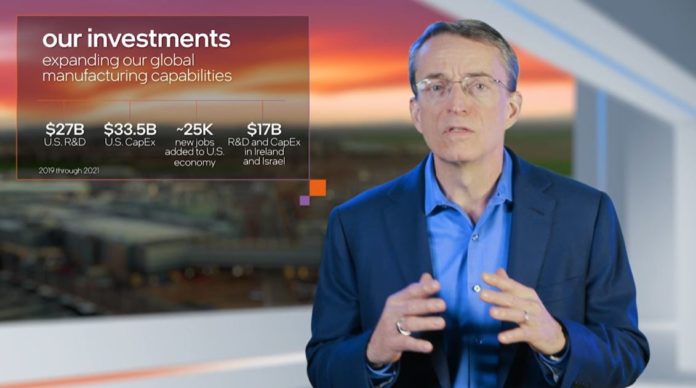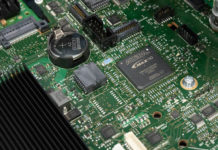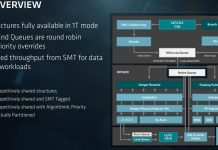In a tenure just under four years since Pat Gelsinger exited VMware to take on CEO role at Intel, Intel just announced his retirement. This comes at a critical juncture for Intel, and the company named interim co-CEOs while its board undertakes a monumental task of finding Pat’s replacement.
Pat Gelsinger Out as Intel CEO
Intel’s news release noted that this was effective on December 1, 2024, but it was not announced until the following day, December 2, 2024. Timing wise, this happened just after one of Pat’s big projects, getting CHIPS Act money, made some progress a few days ago. It also happened fast enough that Intel did not have a news release ready for December 1.
One of the reasons for a sudden CEO departure is usually health. CEOs that engage in these prolonged high-risk turnarounds often suffer physical effects. That is not talked about as much, but it is a real thing that I have seen a number of times. Sometimes family challenges are a reason for retirement. Just having seen my father run multi-billion dollar tech companies for many years, it feels like Intel would be handling this in a strange manner. Usually health concerns give enough notice for a press release to be prepared. Likewise, family time necessarily suffers in roles like this. I know executives who have had immediate family members pass or be hospitalized and their teams cover long enough for a press release to come out.
On November 27, Pat was sharing photos in Memphis at the xAI Colossus cluster, on the less advanced air-cooled Dell side (you can see these are air cooled nodes from the photo):
And here’s a pic from my visit! Thanks for the time! pic.twitter.com/u3W8ZGSM0e
— Pat Gelsinger (@PGelsinger) November 27, 2024
Assuming Pat was securing CHIPS Act money and touring the xAI Colossus last week, it is very strange that a planned retirement would not have a press release on the same day.
Perhaps the point is that this does not look like an organized transition of power, even one that has had a 12-hour window to prepare.
The fact is that, intentional or not, Intel’s actions look like Pat and the Board disagreed to the point that Pat retired. Was it Products not taking clear leadership in multiple segments? Intel’s next-gen server platform getting delayed? Fab and Foundry progress ramping 18A or getting customer contracts? The outcome of the CHIPS Act? The whiff on AI chip ramp? To be fair, many of these challenges were set in motion before Pat’s tenure.
Pat’s tweet on December 1, 2024, the day he resigned was not “Thank you to Intel.” It was one of his Bible quotes:
“I will give thanks with my whole heart; I will tell of all your wonderful deeds.” Psalm 9:1
— Pat Gelsinger (@PGelsinger) December 1, 2024
In the press release, it was also announced that Pat was stepping down from the Board, and there was no mention of a transition support agreement. Usually, if the split was on positive terms, Boards will give CEOs a way to stay connected to the company in even a limited role to help with vesting and benefits. This looks like it was an immediate split.
This does not feel like an amicable split. Our best guess is that activist investors and the Board aligned to force an ouster.
What is Next For Intel?
Intel’s board announced that “David Zinsner and Michelle (MJ) Johnston Holthaus, as interim co-chief executive officers while the board of directors conducts a search for a new CEO.” David is Intel’s CFO and Michelle is perhaps best-known as the lead of Intel’s Client group. MJ is getting named the CEO of Intel Products. Congrats to MJ on the new role!
Question #1 should be whether the Board is contemplating a split. Altera is on its path. Intel Foundry has been operating more independently. Now there is an Intel Products CEO. Is this a precursor structure to a split?
Question #2 is who the heck do you get to lead Intel if it is not split? The board needs to find someone at least between a Lisa Su (AMD) and a Jensen Huang (NVIDIA) and those individuals are hard to find. Lisa and Jensen deal more with the Intel Products side, so taking on huge long-term capital expenditures with Intel Foundry is another level. In a world where Intel itself has been splitting the operating model, and other players are split, the Board is unlikely to find someone with the right experience without that individual also taking a leap.
The biggest learning is perhaps that Intel tends to do better with someone who has an engineering background.
Question #3, given the above, is what happens to Intel Foundry if it is split? It still needs a lot of capital and effort to get to a point where it is a standalone company.
Final Words
Just to be clear, we did not get the reasons for Pat’s retirement, but everything feels like the Board made the move. The question is whether this leads to an Intel Foundry and Intel Products split. If that is the case, it also likely means that the activists will move to get value from an Altera spin sooner rather than later. We also need to get clarity on how Intel Foundry has a path to a standalone entity from a financial perspective. 18A looks great, but this is a long lead time business.
Our hope out of all of this is that Intel gets back to competitiveness. A big challenge is that Intel is not in the strongest position, and whoever takes over will have to execute a series of high-risk maneuvers to right the ship(s.) If the Board makes the wrong choice at this juncture, it will be disasterous for Intel.





I wouldn’t say that Pat was setup for failure but he certainly walked into the company when it was a mess. Are thing better now than they were when he started? On the fab side of things, the answer is seemingly yes so far.
From a processor perspective, they weren’t doing so well when he arrive and doing about the same as he is leaving. Their design teams took too long to adopt a chiplet like strategy and should have moved as soon as they knew 10 nm was in trouble (in fairness, this was before Pat became CEO). Their current server processors are once again competitive but for most of Pat’s term they lagged behind. A too little, too late scenario. Desktop processors are a full disaster with the recent 13th and 14th gen stability issues along side a performance regress with Arrow Lake in many scenario. Lunar Lake for the market it is intended for is actually pretty good but that is only a subset of laptops with Arrow Lake arriving to mobile in a month or two. The silver lining is that Arrow Lake should be an improve in mobile as Intel didn’t (couldn’t?) push Raptor Lake as hard with Meteor Lake only matching Raptor Lake performance. Intel cancelled their last IDF so it is difficult to get a real feel about their future processor roadmap as much of that is alluded to there.
As for the rest of the company in terms of M&A, Pat did manage to get this under control. Perhaps Pat did too much here to keep things afloat for else where. Case in point where the rapid attempts at getting out a major ML architecture that three of them have failed under Pat. Nervana did get silicon out but the fabled Xeon + Nervana hybrid chip never manifested. Ponte Vecchio was late and expensive with the rest of the market moving past its performance class. Gaudi-3 did ship but after the Blackwell’s announcement, taking most of the wind out its sails in terms of interest. However it is seemingly doing better than their other attempts. What would have helped the Gaudi-3 platform would be some robust Ethernet switches which Intel bought Barefoot Networks to do and then wrote them off on the books before Gaudi-3 arrive on the market. There is a synergy there that they could have leveraged to better both parts of the business and failed to execute. A similar pattern could be seen with Altera which was acquired before Pat came on board but was recently spun off. Similarly there was little integration between Xeon and FPGA while under the Intel banner (at least publicly, I’m looking at you Microsoft). I think there is a missed opportunity for Intel by not including a small FPGA chiplet into various Arrow Lake designs to handle accelerators. For consumers it doesn’t make sense to spend the silicon on the wide range of hard accelerators due to the mix of workloads they handle but a programmable chiplet could be useful and then be able to charge consumers for the soft logic designs to run on them.
One positive thing for Pat was securing CHIPs funding. In hindsight this is going to be seen as the life blood for the company that was going through some very rough times.
And lastly graphics which probably should be mentioned that Battlemage is due to be revealed this week. This will likely overshadow the announcement of new GPUs, especially given that Battlemage looks to be only low end/midrange cards at best and arriving only a month before new nVidia and AMD designs. Alchemist was a VERY rough launch with the software side being barely functional at launch and extremely buggy. Performance was lackluster with Alchemist often performing worse than cards using an older process node and less power. Intel does need to do graphics if only for their integrated graphics and expanding that into desktop makes sense on paper but the execution has been nothing but flawed. Pat was the big defender of graphics but with him gone, I would imagine the next two architectures on Intel’s roadmaps to be quietly forgotten.
So Pat ultimately got the fabs straightened out and made less foolish M&A decisions but the rest of Intel pretty much carried on in the same way as before hand. You have to most the entire ship when correcting course. If you only move starboard, then you rip the ship apart.
Hmmm, will Lisa Su move over to the Dark Side!!?
Balanced take
A balanced take from Patrick as always.
Intel has been chopping away its limbs in such rapid succession (non-volatile memory, networking, etc.) that certain product synergies have been lost. With Pat ousted I seriously doubt there is a future for the company in its current form; perhaps it will become a pet project of the U.S. government propped up by taxpayer funded subsidies.
So many divisions and employees have been cut, but anything to create shareholder value, right?
The big question is if a Taiwan takeover by the CCP will arrive quickly enough before Intel is split up and its profitable parts sold off to the highest bidder.
I’m not sure anyone can stumach the billions needed to keep the fab business from falling behind further until that happens.
Hey Pat, according to Bloomberg: Intel CEO Forced Out by Board Frustrated With Slow Progress
https://www.bloomberg.com/news/articles/2024-12-02/intel-ceo-pat-gelsinger-retires-amid-chipmaker-s-turnaround-plan?srnd=homepage-europe
Pat is fairly close to his plan at this point, so it is strange saying slow progress other than in the AI space. Just wait a bit. My sense is Intel is heading for some major restructuring pushed by activist investors.
I think the decision to spin off networking and nonvolatile memory were non-optimal; however, Pat did have a long-term plan and letting activist investors (corporate raiders) disrupt that is in my opinion very bad news for the future of Intel.
“If the Board makes the wrong choice at this juncture, it will be disasterous for Intel.”
The Board already made the wrong decision on Dec. 1st.
Gelsinger talked a good job but the fruits of his aspirations never came to pass; and, unfortunately for him, that CEO post was a poisoned chalice as Intel had too many performance shortfalls, be it in manufacturing or design, to turn this behemoth around.
At a New York financial analyst meeting in the early 2000s, former Intel CFO Andy Bryant said this: Strategy is Everything. And he went on to explain what that meant with respect to Intel’s four pillars: 1. Process Technology, 2. Architecture. 3. Memory & Storage, & 4. Interconnect. Later in 2018 Intel added: 5. Security, & 6. Software.
At the time of that early 2000 presentation, no one was remotely close to Intel’s leadership when looking at those 4 pillars as a combined whole. But slowly over time, Intel’s leadership in those pillars was slowly eroded away to the point where it can be argued today that Intel doesn’t lead in any of the areas that really matter. And when you think about the areas of expertise that would be needed to gain that leadership again, I really don’t know if Intel today has the depth of talent to turn those deficiencies around. Intel is very much like the Jack of all trades but a master of none, which is why it performs so dismally today.
If Intel can be turned around it will take a visionary to do it – it could be argued that Gelsinger was that person as he not only had a vision but he also had a plan to back it up. But who in their right mind would take on such a role unless that individual had total carte blanche authority? I really do fear for Intel, if the wrong decisions are made it could unravel as a company real fast.
Maybe Elon Musk is interested, he doesn’t seem to have enough on his plate if he’s got time to play Diablo ;)
All kidding aside, I thought Gelsinger was a great choice for Intel but obviously it’s going to take longer for his strategy to play out, he at least got Intel back on track to being competitive with AMD in the server space. I feat that the board will now hire someone with little background in technology again who will focus on the financial gimmicks that have gotten Intel in trouble on the technology front in the first place – meaning a focus on mergers, spin-offs, acquisitions and all that other stuff that plays well in the stock market but doesn’t build a sustainable business. Those fab investments take a long time to play out. It seems to me that Dr. Lisa Su was given more time to get AMD back on track and she’s performed well as a result of that including great hiring decisions.
I don’t think a “visionary” will fix intel.
No, the rot began in the management long ago.
It’s only that Intel having their dominance eroded by everyone else that the rot accelerated.
I do think it’s intel management that has issues (as alluded to by past intel employees) and the CEO is really there to be a talking head and fall guy
Like who thought it was a good idea to rubbish the company that nearly died that’s now ahead of you?
And talking smack of your manufacturing partners?
Or rejecting reality and claiming the most used (and the reason why their hardware is popular) code framework is expired
He probably didn’t want to say all those I hope. I hope it’s some buffoon in intel writing smack that he was forced to say
This guy made all the wrong bets and spent huge sums of $ the company didn’t have the revenue or government subsidies to support, made a lot of inane statements about his competitors and technology, prophesied so many things that turned out to be false about future products and nodes, released under his watch defective and uncompetitive products, and ran a 56 year old company into the ground. For all of that, during his brief 4 years as CEO, was paid hundreds of millions.
Well, it looks like what they say: “HE GONE”. Now, I wonder what the future holds for Intel. If what I’m reading from other comments here is to be believed, it ain’t lookin’ so good.
I agree with @Dave, the whole “glued-together processor” thing was not their finest moment. Thumbing their collective noses at AMD for using a disaggregated, circuit-design optimized and cost-reduced means of producing ever larger CPUs and GPUs using modularized components was kind of a dick move, only for Intel to then turn around and start making their own chiplet-base processor designs when they discovered that the monolithic approach is untenable beyond 20 or so cores, both engineering-wise and cost versus scalability-wise as well as the very real hard physical limit to reticle size in chip fab machinery. I mean, how stupid did they really have to be. AMD went all “Comeback Kid” on ’em, beat their asses bloody and never looked back. As a result, the EPYC line is less expensive than the Xeon competition, consumes less power (at least initially) and has better overall performance clock cycle-to-clock cycle.
Also, that claim they made about x86 being “expired”. Didn’t they say that back when the whole fiasco surrounding Itanium hit the fan?… Oh… Right… They must have FORGOTTEN the Itanium which bombed massively and NEVER fulfilled even the most rudimentary of goals Intel set out for it. The processor that would replace x86 AND RISC in one fell swoop…yeah right.
Considering one of the two co-CEOs is a marketing person, I expect the death spiral to continue.